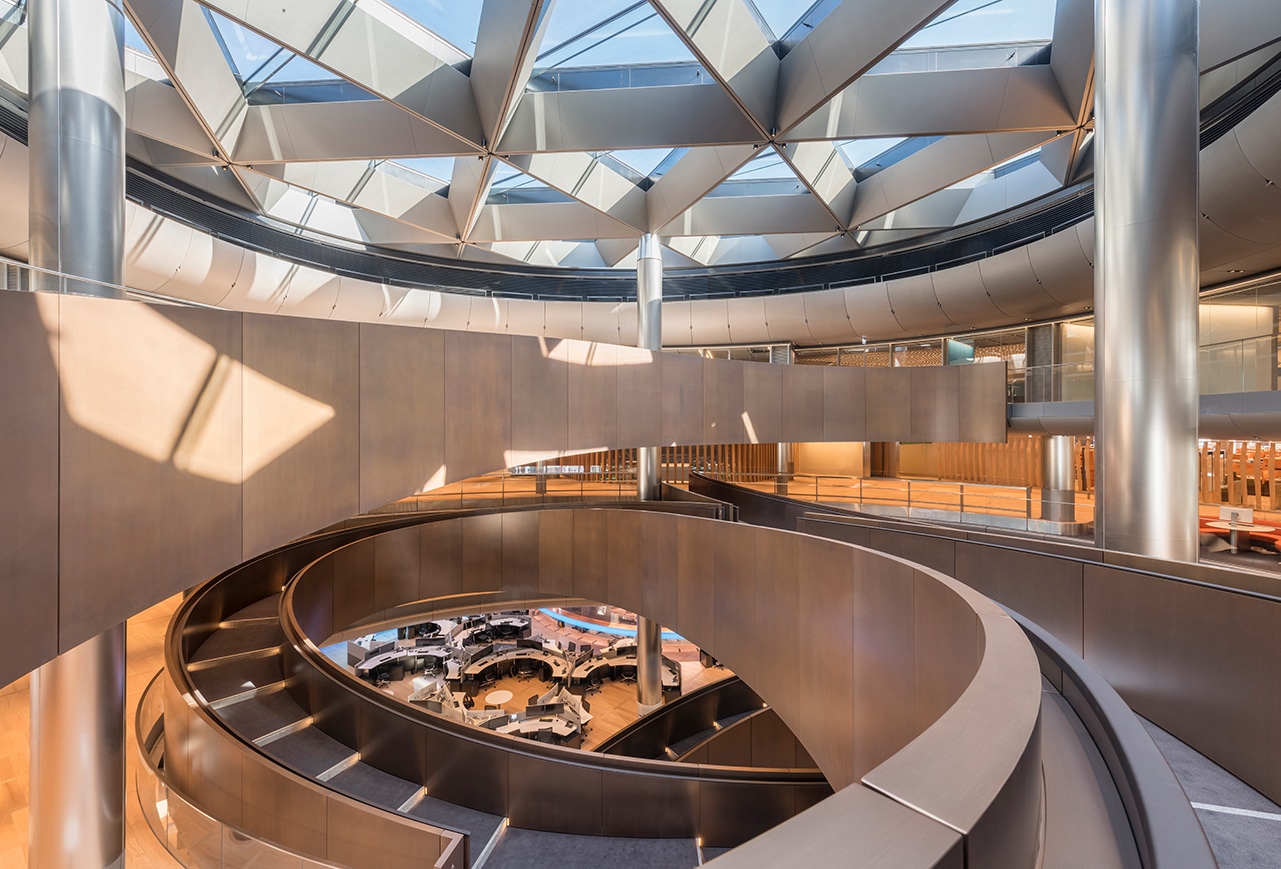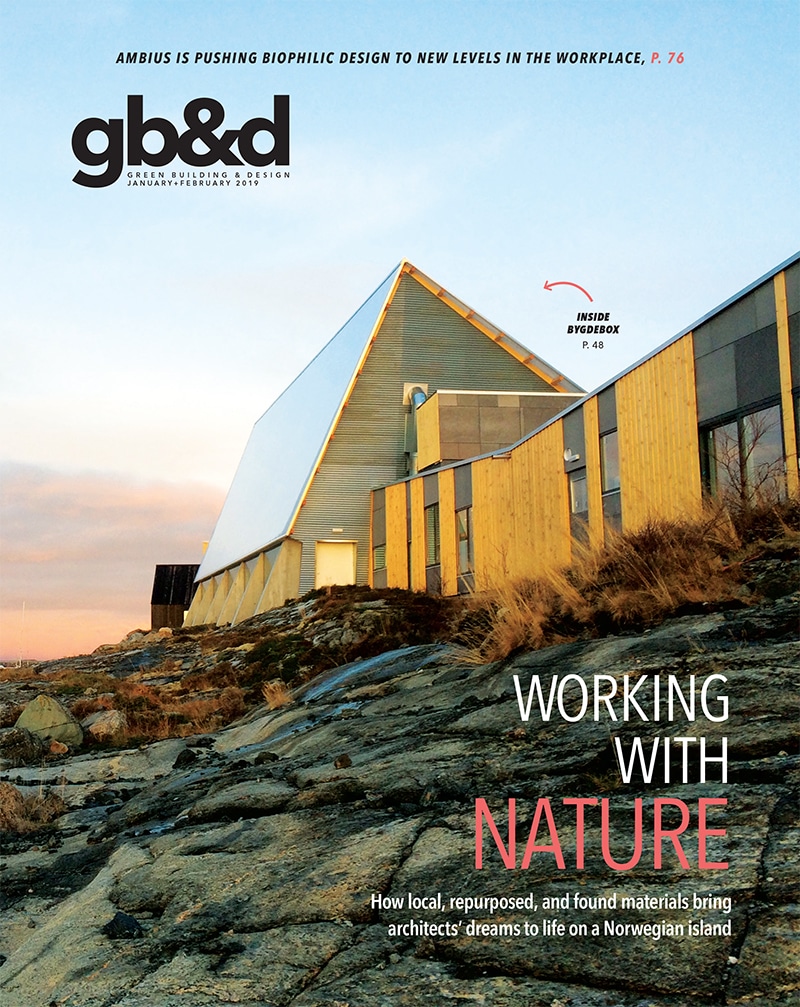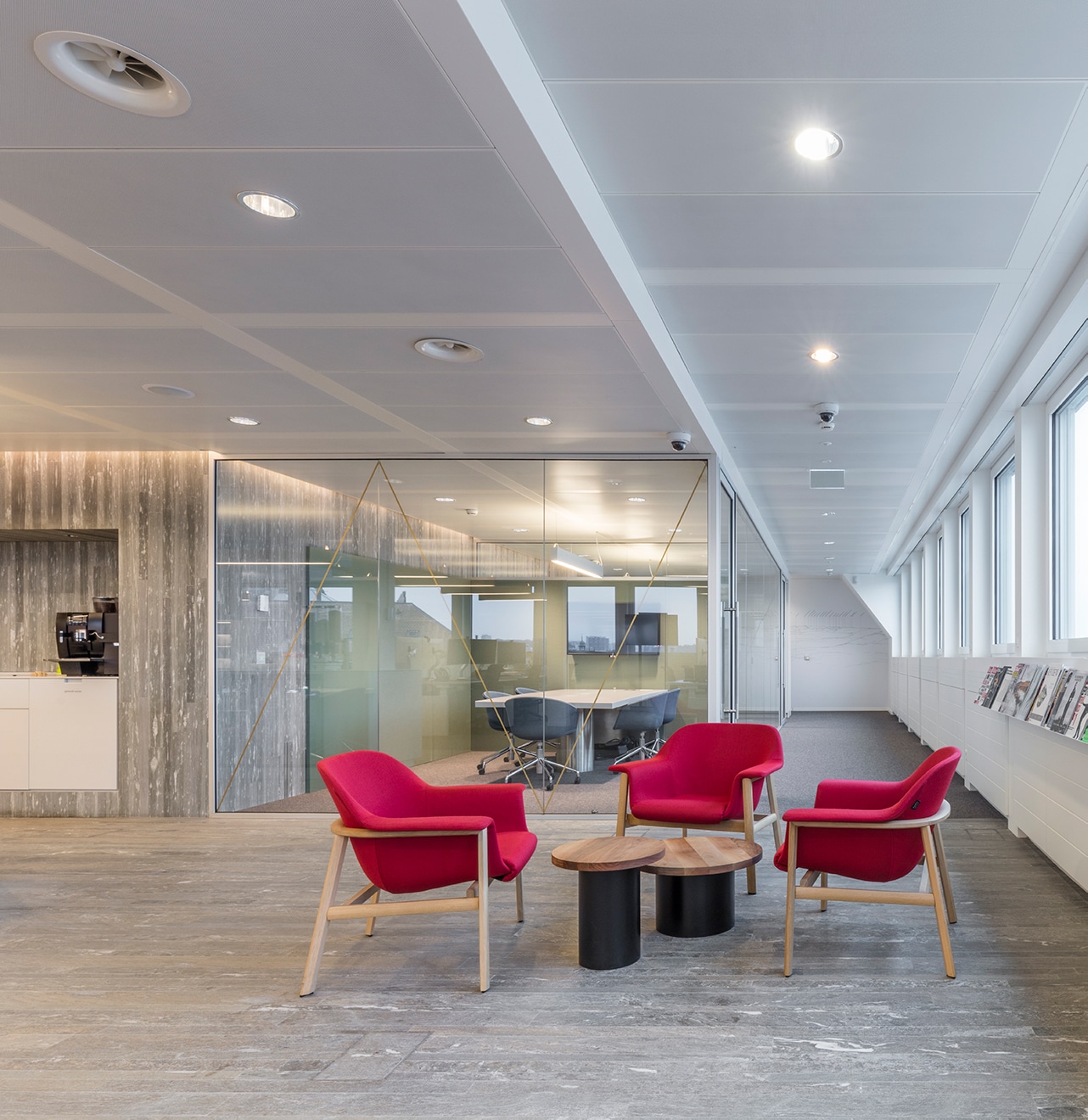
London [Photo by James Newton]
More than 70% of employees work in a LEED- or BREEAM-certified space, but the media company doesn’t stop there.
No more fighting for corner offices or window views. What was once a struggle under fluorescent lights in drab cubicles is now a collaborative environment with flexible, light-filled spaces.
It’s no secret—at least not in the green building industry—that healthier buildings lead to happier employees. A recent USGBC survey found employees who work in LEED-certified green buildings are happier, healthier, and more productive than employees in non-LEED or conventional office buildings.

Bangkok [Photo: Wison Tungthunya]
FROM OUR JAN+FEB 2019 ISSUE

The preferred publication of leading green professionals.
Human-Centric Design
In Bloomberg buildings, office design is increasingly human-centric, from the moment an employee walks in the door. “Responsible design is the rule rather than an exception for us,” says Christiaan Hiemstra, Bloomberg’s global head of design. The company has long been a leader in sustainable design but also recently earned the moniker of “world’s most sustainable office space” for the new European headquarters in London (as per BREEAM standards). The 10-story facility earned a 98.5% BREEAM rating, the highest score for an office building to date.
For Bloomberg, responsible design includes everything from local input to material selection to how you move around in a building. A focal point of the London office is its continuous ramp, which flows throughout the building and encourages conversation while acting as a chimney, where natural air flows up to the building’s atrium and out onto the roof.
Conversation starters like the ramp are nothing new for Bloomberg, though. The company’s building at 731 Lexington Avenue in Manhattan—which received the highest Fitwel rating—also encourages movement and conversation, but using stairs. Elevators don’t stop on every floor, and employees are encouraged to take the stairs unless unable to. “It’s a big part of that active design we’ve always done naturally,” says Michael Barry, head of sustainable business operations at Bloomberg. “We do that in all of our workspaces. We don’t want people to have to go on an elevator to go two or three floors. A, it’s healthier for them, and B, we want people to bump into each other and talk and have a spontaneous conversation that might lead to a new idea.”
Where and how people work affects employees’ lives in a big way, Hiemstra says, and even things like where to find the coffee can impact an employee’s happiness and productivity. “From a corporate perspective, the people are the most important part of our business. And you’re designing their environment.”
The experience of a building is crucial to its design, especially ensuring everyone has access to views and daylight. Bloomberg thinks about every element of experience, from security to waiting for an elevator to where doors are located. The design principles continue to evolve as Bloomberg considers how people work and collaborate, with a focus as well on comfortable lighting and acoustics. Now, every desk is height adjustable so employees have the option to stand, for instance. And collaborative spaces are plentiful, from meeting rooms without walls to pantry areas you can also get work done in. “We give them spaces that work for them,” Hiemstra says. When it comes to saving energy, Bloomberg uses daylight sensors and even plumbing features that detect when no one is in a room, so not only do the lights shut off, the master plumbing shuts off as well. This also helps prevent leaks and drips.

Amsterdam [Photo: Machteld Schoep]
It’s All in the Approach
Literally dozens of Bloomberg’s 176 offices are certified—more than 70% of their employees work in a LEED or BREEAM space. The leadership isn’t working just to amass accreditations, though. They’re thinking about how people are affected and letting that drive their design choices. “We spend a lot of time building the rules to which our architects design,” Hiemstra says, adding that they don’t define what materials an architect should use or how things should look, though.
Instead, they enter partnerships that make sense. By now, anyone who works with Bloomberg understands the company’s ethos and is on board to meet their human-centric objective. “We think about everything—from the details of functionality to the aesthetics to the subconscious wellbeing aspect of the space and people who work there.” Considering most employees spend a third of their lives in the office, it’s no small commitment, Hiemstra says.
Bloomberg starts local—hiring the people who know a place best, whether the building is in Prague or Hong Kong. “You’re gaining a massive amount of benefits from doing that,” Hiemstra says. He looks to Prague as a stellar example of local teams in action. “Everything about that design was done in the right way. Everything from the relationship with the local team who was absolutely incredible to the way we selected materials.” Furniture came from the Czech Republic and even the graphic design team was local. “We really learned about the history of the country,” Hiemstra says. “Just through designing graphics, we learned about what was important to people there.” Typically, Bloomberg briefs the local team about the company’s mission while the design team on the ground teaches Bloomberg about the local culture. “If you’re building an office in Prague, you’re not building a New York headquarters. You’re building a piece of local tradition.”
Hiemstra says tailoring that design is vital. “The other way of doing it is basically having globally centric design solutions, which a lot of companies do, where they have materials that are pre-set because that’s the aesthetic that’s been selected on a global scale,” he says. “It’s just not the right thing to do. Understanding that you’re a guest and you are a visitor there is a crucial part. And understanding how you can attain the knowledge, the expertise, the intellect, and the knowledge of the local culture and location is very important.”
Choosing the right building, that’s centrally located with access to transportation, is also key. Healthy design for Bloomberg in general includes a series of “musts,” things like LED lighting and pushing building owners to manage waste responsibly. Then there are the beautiful, sustainable features—even things like fish tanks or rounded, collaborative desks. Of course, the company also focuses on materials. “In addition to having a green workspace, we want to have a healthy workspace so we’re naturally using materials with low VOCs and really focusing on the material resource points,” Barry says.
Bloomberg also continues to push the industry with initiatives like separating liquids from waste and stacking cups. It’s as simple as pouring the liquid out before you throw your cup in the trash, and yet so many people don’t do it. “No office is good enough in my opinion. Everything can always be improved,” Hiemstra says.

Geneva [Photo: Nicholas Worley]
Goals That Inspire
“Our buildings and our offices have always been an important part of our culture,” Barry says. When sustainability officially started in Bloomberg in 2007, one of the first things the company looked at as a group was its emissions. “In our offices, energy is 55% of our annual emission. It’s the biggest part of our emissions, so we really focused in on what we could do in the built environment.” Bloomberg aims to have a 20% absolute reduction in emissions by 2020.
A little more than a decade ago, Bloomberg looked to LEED—the first standard of its kind. Bloomberg did its first LEED project in 2008 in San Francisco. The Pier 3 building on the Embarcadero in an old warehouse is still one of Barry’s favorite projects. “We realized building with LEED isn’t that much more difficult than doing our regular fit-out. Also, it provides a lot of transparency as to all the contractors and the people involved in the project doing what you’ve asked them to do. And then at the end, because of the rigorous standard and having this documentation, you get validation that you’ve achieved what you set out to.”
Collaboration is also key. Continuing to share knowledge and work with others for the greater good is core to Bloomberg’s mission. While Barry is part of the Renewable Energy Buyers Alliance and the Sustainable Purchasing Leadership Council, Bloomberg itself is a major player in the New York City carbon challenge. “Companies pledge to reduce their New York City emissions by a certain percentage by a certain time. We have a 50% goal by 2023.” Bloomberg is also working toward 90% waste diversion overall by 2020.
Barry says net zero should be the goal of offices in the future. “We’re a member of RE100, so we’ve pledged to get 100% of our energy from renewable sources by 2025, which is a great goal, but a lot of these are offsite wind farms. We’ve done a few onsite projects where we can, but ideally we’d figure out ways for offices to have a net zero impact; that’s really where things need to go. The built environment, especially in urban areas like New York City, is the majority of carbon emissions, and it’s important for new projects that come online to continue to push the bar.”
